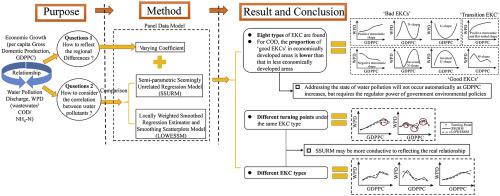Journal of Cleaner Production ( IF 9.7 ) Pub Date : 2020-07-17 , DOI: 10.1016/j.jclepro.2020.122783 Hao Cai , Yadong Mei , Junhong Chen , Zhenhui Wu , Lan Lan , Di Zhu

|
The study of the relationship between water pollution and economic growth holds great significance for sustainable development. Under Environmental Kuznets Curve (EKC) hypothesis, this paper focuses attention on a Chinese context and investigates the relationship between water pollution discharge--waste water (WW), chemical oxygen demand (COD) and ammonia nitrogen (NH4–N) and economic growth--per capita Gross Domestic Production (GDPPC), based on a comparison of the results from two variable coefficient panel data models–-a Locally Weighted Smoothed Regression Estimator and Smoothing Scatterplots Model (LOWESSM) which is a nonparametric model, and a Semi-parametric Seemingly Unrelated Regression Model (SSURM) which considers the contemporaneous correlation of water pollutants that most previous studies have ignored. The empirical results indicate that there exist differences that can be represented by the characteristics of different EKC types, or different turning points under the same EKC type and that the SSURM may be more conducive to reflecting the real relationship between water pollution and economic growth. The study also finds that there are eight types of EKC which can be categorized as “good EKCs” (negative monotonic shape, inverted N-shape, inverted U-shape and M-shape), “bad EKCs” (positive monotonic shape, N-shape and U-shape) and “transition EKC” (positive monotonic and flat-tailed shape) and the proportion of “good EKCs” in economically developed areas (71.43%) is lower than that in the less economically developed areas (76.47%) in terms of COD discharge. Results suggest that addressing the state of water pollution will not occur automatically as GDPPC increases, but requires the regulatory power of government environmental policies.











































 京公网安备 11010802027423号
京公网安备 11010802027423号